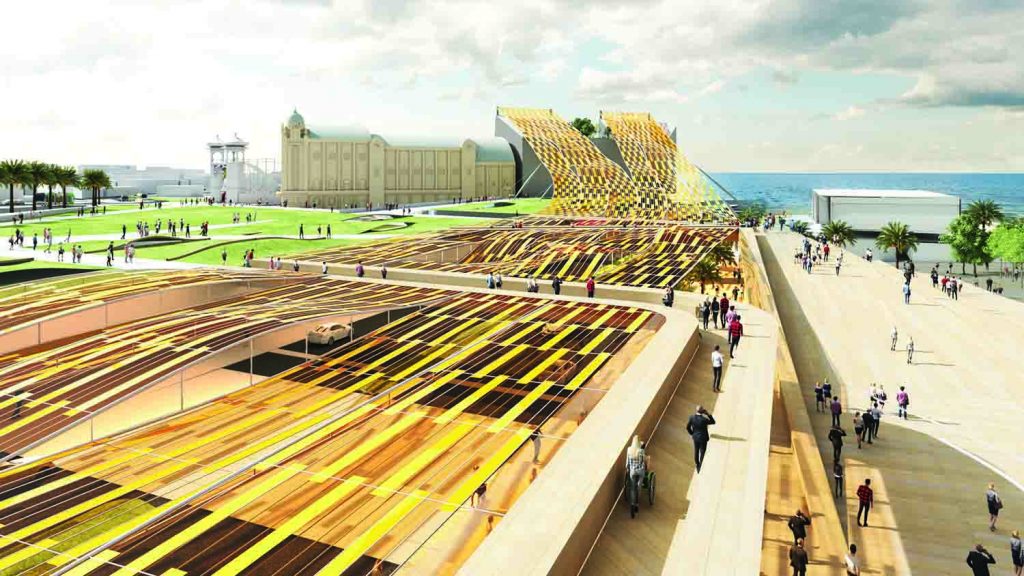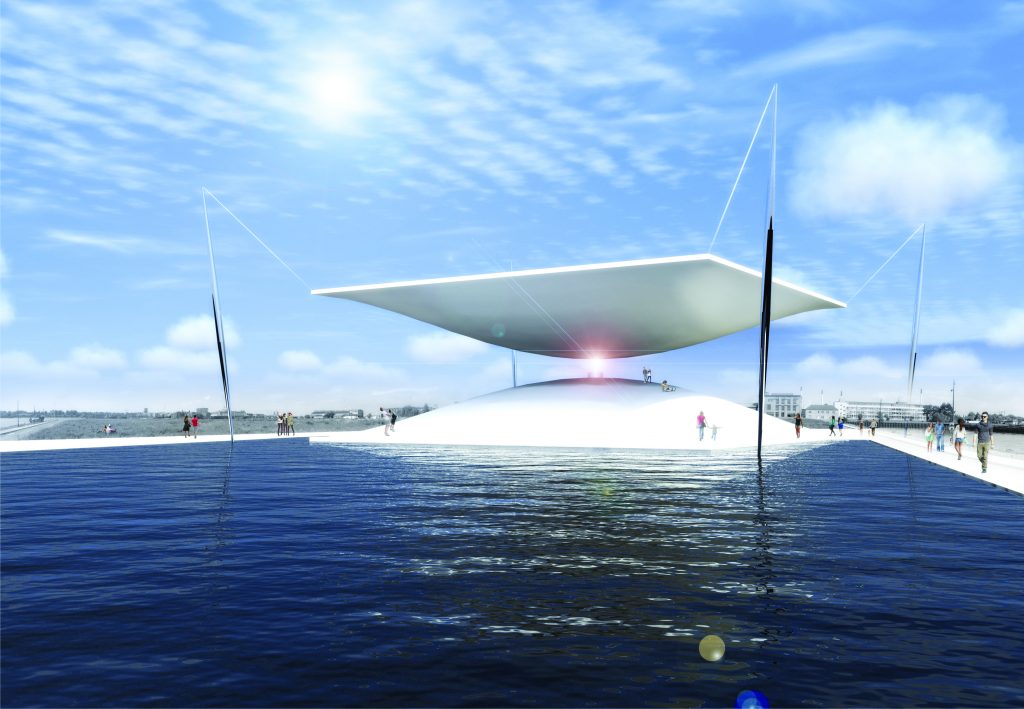Sustainable infrastructures will be the cultural landmarks of the 21st century.

Artist Team: Martin Heide, Dean Boothroyd, Emily Von Moger, David Allouf, Takasumi Inoue, Liam Oxlade, Michael Strack, Richard Le; Mike Rainbow, Jan Talacko; John Bahoric; Bryan Chung, Chea Yuen Yeow Chong, Anna Lee, Amelie Noren
Energy Technologies: flexible mono-crystalline silicon photovoltaic, wind energy harvesting, microbial fuel cells
Annual Capacity: 2,220 MWh
A submission to the 2018 Land Art Generator design competition for Melbourne
It’s not often that you want to do the things you have to do, but the great energy transition is an exception. Because radically and equitably transforming our energy infrastructure over the next decade will create a massive economic boom (we have a lot of stuff to build!), continued expansion in quality of life and well-being for all Americans, and will save future generations trillions of dollars that they can instead put into other good uses. They will thank us as they look back at this heroic time in American history when the Boomers, Gens X, Z, and the Millenials led the charge to save life as we know it on this planet.
When our grandchildren look back on the great things that we will build over the next decade, what is it they will see? They will see solar farms, wind turbines, and transmission pylons. They will see facilities dedicated to zero waste, anaerobic digesters, and biochar plants across the American Midwest. They will see net-zero water treatment facilities and sustainable transportation hubs. But what will this infrastructure look like, how will it relate to human culture, and how will it impact the aesthetics of our cities and our rural landscapes?
The Green New Deal resolution - co-sponsored by Senator Markey and Representative Ocasio-Cortez - takes its cue from the original New Deal, a component of which was a major investment in American public infrastructure. By executive order, FDR created the Works Progress Administration on May 6, 1935 and its first Congressional appropriation under the Second New Deal was 6.7% of 1935 GDP (that would be a trillion dollars today), funded with a 79% top marginal income tax rate and higher taxes on corporations (the undistributed profits tax).
When Generation Xers look back at the great things that our grandparents built at that important time in history, what do we see, and what does it look like? We see the Hoover Dam, providing 4.2 terawatt-hours of clean electricity every year, and around it we see the artwork of Denver artist Allen Tupper True and Norwegian-American sculptor Oskar J.W. Hansen. We see murals on civic buildings like those by Acee Blue Eagle in Oklahoma. We hear the voice of Woody Guthrie, hired by the government to compose songs about the new Bonneville and Grand Coulee Dams. He celebrated the Grand Coulee Dam “as the creation of the common man to harness the river for the common good - work for the jobless, power to ease household tasks, power to strengthen Uncle Sam in his fight against world fascism.” We see the murals of John Augustus Walker, a native of Mobile, Alabama that tell the history of his city. We see the early gestures of abstract expressionism from WPA artists like Jackson Pollock. We see the totems in Alaska by artist George Benson (Lkeináa). We see the novels of John Steinbeck and Zora Neale Hurston. We see the legacy of more than 100 community art centers throughout the country that were established under the New Deal. We see the work of 10,000 artists who were employed by the federal government and who helped to guide American culture through our recovery from the Great Depression, gilding the electrical power infrastructure and public buildings with their art, and defining the era with stories, beauty, relevance, and creativity.

The reason we have this rich cultural legacy to look back on is because a fundamental component of the New Deal was the Federal Art Project directed by Holger Cahill, who believed in the importance of art to speak to the public. Cahill told the New York Times in December, 1937:
We have subordinated art to our desire to pile up personal possessions, to our interest in conspicuous display and conspicuous waste. We have subordinated art to our consuming passion for commercial success, to our materialistic will-to-power. We have subordinated art to our love of rivalry, our passion to outdo others in competitive activity and we have subjected it further to the whims of social snobbery, the erratic interests of dilettantism, to arbitrary judgments and irresponsible criticism. And in doing so we have helped to push art from its honorable place as a vital necessity of everyday life and have made of it a luxury product intended for the casual enjoyment of jaded wealth.”
– The Living New Deal
Our notion of art’s role in society has evolved since 1937 and we owe some of that to Cahill’s influence. Today, artists like Buster Simpson are working with stormwater, artist Betsy Damon is collaborating on water treatment facilities, artists are designing clean power plants and Solar Mural projects with the Land Art Generator, and new media artists like those in the Leonardo ISAST network are using big data and mass public engagement to inform public policy. Hundreds of artists today are out on the streets, educating people on a panoply of issues around climate change mitigation and adaptation, helping neighborhoods see that a community energy installation can be more than just solar panels on the ground behind a chain-link fence. That these new infrastructures can open opportunities for new public parks, community gardens, and other shared land uses, can create innovative income streams for marginalized neighborhoods, bring new ways of collaborating and exchanging value in society.

An investment in new, resilient, and sustainable public infrastructure on the magnitude of the 1930s New Deal is exactly what we need right now as we face the existential challenge of climate change. As we craft the legislation and make this investment to safeguard our future, let’s remember to include artists and designers of all backgrounds on the teams who craft the laws, in the offices that implement them, and on the crews that design and build the sustainable infrastructure of the 21st century, so that our grandchildren will have the stories to learn, beauty to appreciate, and a cultural legacy to be inspired by as we were inspired by the legacy of the previous century’s infrastructure investment.
It could be argued that the art of the New Deal helped to solidify its political support. For those today who want a Green New Deal but are skeptical of its ability to pass Congress, consider empowering artists to show us all the beauty and promise of a post-carbon future.
Artists are ready to contribute to the Green New Deal.
Related Posts
1 Comment
Add comment Cancel reply
This site uses Akismet to reduce spam. Learn how your comment data is processed.

[…] balance with nature can at the same time make our cities more culturally vibrant and beautiful. See this […]